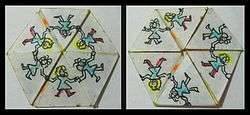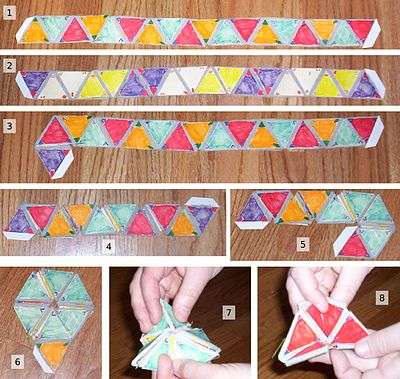Flexagon

In geometry, flexagons are flat models, usually constructed by folding strips of paper, that can be flexed or folded in certain ways to reveal faces besides the two that were originally on the back and front.
Flexagons are usually square or rectangular (tetraflexagons) or hexagonal (hexaflexagons). A prefix can be added to the name to indicate the number of faces that the model can display, including the two faces (back and front) that are visible before flexing. For example, a hexaflexagon with a total of six faces is called a hexahexaflexagon.
In hexaflexagon theory (that is, concerning flexagons with six sides), flexagons are usually defined in terms of pats.[1][2]
Two flexagons are equivalent if one can be transformed to the other by a series of pinches and rotations. Flexagon equivalence is an equivalence relation.[1]
History
Discovery and introduction
The discovery of the first flexagon, a trihexaflexagon, is credited to the British student Arthur H. Stone, who was studying at Princeton University in the United States in 1939. His new American paper would not fit in his English binder so he cut off the ends of the paper and began folding them into different shapes.[3] One of these formed a trihexaflexagon. Stone's colleagues Bryant Tuckerman, Richard Feynman, and John Tukey became interested in the idea and formed the Princeton Flexagon Committee. Tuckerman worked out a topological method, called the Tuckerman traverse, for revealing all the faces of a flexagon.[4]
Flexagons were introduced to the general public by the recreational mathematician Martin Gardner in 1956 in the first Mathematical Games column which he wrote for Scientific American magazine.[3] In 1974, the magician Doug Henning included a construct-your-own hexaflexagon with the original cast recording of his Broadway show The Magic Show.
Attempted commercial development
In 1955, Russell Rogers and Leonard D'Andrea of Homestead Park, Pennsylvania applied for a patent, and in 1959 they were granted U.S. Patent number 2,883,195 for the hexahexaflexagon, under the title "Changeable Amusement Devices and the Like."
Their patent imagined possible applications of the device "as a toy, as an advertising display device, or as an educational geometric device."[5] A few such novelties were produced by the Herbick & Held Printing Company, the printing company in Pittsburgh where Rogers worked, but the device, marketed as the "Hexmo", failed to catch on.
Varieties
Tetraflexagons
The tritetraflexagon is the simplest tetraflexagon (flexagon with square sides). The "tri" in the name means it has three faces, two of which are visible at any given time if the flexagon is pressed flat. The construction of the tritetraflexagon is similar to the mechanism used in the traditional Jacob's Ladder children's toy, in Rubik's Magic and in the magic wallet trick or the Himber wallet.
A more complicated cyclic hexatetraflexagon requires no gluing. A cyclic hexatetraflexagon does not have any "dead ends", but the person making it can keep folding it until they reach the starting position. If the sides are colored in the process, the states can be seen more clearly.
Hexaflexagons
Hexaflexagons come in great variety, distinguished by the number of faces that can be achieved by flexing the assembled figure. (Note that the word hexaflexagons (with no prefixes) can sometimes refer to an ordinary hexahexaflexagon, with six sides instead of other numbers.)
Trihexaflexagon

A hexaflexagon with three faces. This is the simplest of the hexaflexagons to make and to manage, and is made from a single strip of paper, divided into ten equilateral triangles.
Hexahexaflexagon
This hexaflexagon has six faces. It is made up of nineteen triangles folded from a strip of paper.

Photos 1-6 below show the construction of a hexaflexagon made out of cardboard triangles on a backing made from a strip of cloth. It has been decorated in six colors; orange, blue, and red in figure 1 correspond to 1, 2, and 3 in the diagram above. The opposite side, figure 2, is decorated with purple, gray, and yellow. Note the different patterns used for the colors on the two sides. Figure 3 shows the first fold, and figure 4 the result of the first nine folds, which form a spiral. Figures 5-6 show the final folding of the spiral to make a hexagon; in 5, two red faces have been hidden by a valley fold, and in 6, two red faces on the bottom side have been hidden by a mountain fold. After figure 6, the final loose triangle is folded over and attached to the other end of the original strip so that one side is all blue, and the other all orange.

Photos 7 and 8 show the process of everting the hexaflexagon to show the formerly hidden red triangles. By further manipulations, all six colors can be exposed. Faces 1, 2, and 3 are easier to find while faces 4, 5, and 6 are more difficult to find. An easy way to expose all six faces is using the Tuckerman traverse. It's named after Bryant Tuckerman, one of the first to investigate the properties of hexaflexagons. The Tuckerman traverse involves the repeated flexing by pinching one corner and flex from exactly the same corner every time. If the corner refuses to open, move to an adjacent corner and keep flexing. This procedure brings you to a 12-face cycle. During this procedure, however, 1, 2, and 3 show up three times as frequently as 4, 5, and 6. The cycle proceeds as follows:
1-3-6-1-3-2-4-3-2-1-5-2
And then back to 1 again.
Each color/face can also be exposed in more than one way. In figure 6, for example, each blue triangle has at the center its corner decorated with a wedge, but it is also possible, for example, to make the ones decorated with Y's come to the center. There are 18 such possible configurations for triangles with different colors, and they can be seen by flexing the hexahexaflexagon in all possible ways in theory, but only 15 can be flexed by the ordinary hexahexaflexagon. The 3 extra configurations are impossible due to the arrangement of the 4, 5, and 6 tiles at the back flap. (The 60-degree angles in the rhombi formed by the adjacent 4, 5, or 6 tiles will only appear on the sides and never will appear at the center because it would require one to cut the strip, which is topologically forbidden.)
Hexahexaflexagons can be constructed from different shaped nets of eighteen equilateral triangles. One hexahexaflexagon, constructed from an irregular paper strip, is almost identical to the one shown above, except that all 18 configurations can be flexed on this version.
Other hexaflexagons
While the most commonly seen hexaflexagons have either three or six faces, variations exist with four, five, seven, and twelve faces.
Higher order flexagons
Right octaflexagon and right dodecaflexagon
In these more recently discovered flexagons, each square or equilateral triangular face of a conventional flexagon is further divided into two right triangles, permitting additional flexing modes.[6] The division of the square faces of tetraflexagons into right isosceles triangles yields the octaflexagons,[7] and the division of the triangular faces of the hexaflexagons into 30-60-90 right triangles yields the dodecaflexagons.[8]
Pentaflexagon and right decaflexagon
In its flat state, the pentaflexagon looks much like the Chrysler logo: a regular pentagon divided from the center into five isosceles triangles, with angles 72-54-54. Because of its fivefold symmetry, the pentaflexagon cannot be folded in half. However, a complex series of flexes results in its transformation from displaying sides one and two on the front and back, to displaying its previously hidden sides three and four.[9]
By further dividing the 72-54-54 triangles of the pentaflexagon into 36-54-90 right triangles produces one variation of the 10-sided decaflexagon.[10]
Generalized isosceles n-flexagon
The pentaflexagon is one of an infinite sequence of flexagons based on dividing a regular n-gon into n isosceles triangles. Other flexagons include the heptaflexagon,[11] the isosceles octaflexagon,[12] the enneaflexagon,[13] and others.
Nonplanar pentaflexagon and nonplanar heptaflexagon
Harold V. McIntosh also describes "nonplanar" flexagons (i.e., ones which cannot be flexed so they lie flat); ones folded from pentagons called pentaflexagons,[14] and from heptagons called heptaflexagons.[15] These should be distinguished from the "ordinary" pentaflexagons and heptaflexagons described above, which are made out of isosceles triangles, and they can be made to lie flat.
Bibliography
- Mitchell, David (2000). The Magic of Flexagons – Paper curiosities to cut out and make. Tarquin. ISBN 1-899618-28-7.
- Pook, Les (2009). Serious Fun with Flexagons, A Compendium and Guide. Springer. ISBN 90-481-2502-2.
- Pook, Les, Flexagons Inside Out, Cambridge University Press (2006), ISBN 0-521-81970-9
- Martin Gardner wrote an excellent introduction to hexaflexagons in the December 1956 Mathematical Games column in Scientific American. It also appears in:
- The "Scientific American" Book of Mathematical Puzzles and Diversions (Simon & Schuster, 1959).
- Hexaflexagons and Other Mathematical Diversions: The First "Scientific American" Book of Puzzles and Games (University of Chicago Press, 1988; ISBN 0-226-28254-6)
- The Colossal Book of Mathematics (W.W. Norton & co., 2001; ISBN 0-393-02023-1)
- Hexaflexagons, Probability Paradoxes, and the Tower of Hanoi: Martin Gardner's First Book of Mathematical Puzzles and Games (Cambridge University Press, 2008; ISBN 0-521-73525-4)
- College Mathematics Journal 43(1):1–5 (January 2012); the issue also contains another article by Pook, and one by Iacob, McLean, and Hua.
See also
References
- 1 2 Oakley, C. O.; Wisner, R. J. (March 1957). "Flexagons". The American Mathematical Monthly (Mathematical Association of America) 64 (3): 143–154. doi:10.2307/2310544. JSTOR 2310544.
- ↑ Anderson, Thomas; McLean, T. Bruce; Pajoohesh, Homeira; Smith, Chasen (January 2010). "The combinatorics of all regular flexagons". European Journal of Combinatorics 31 (1): 72–80. doi:10.1016/j.ejc.2009.01.005.
- 1 2 Gardner, Martin (December 1956). "Flexagons". Scientific American. Vol. 195 no. 6. pp. 162–168. doi:10.1038/scientificamerican1256-162. OCLC 4657622161.
- ↑ Gardner, Martin (1988). Hexaflexagons and Other Mathematical Diversions: The First Scientific American Book of Puzzles and Games. University of Chicago Press. ISBN 0-226-28254-6.
- ↑ Rogers, Russell E.; Andrea, Leonard D. L. (April 21, 1959). "Changeable amusement devices and the like" (PDF). Freepatentsonline.com. U.S. Patent 2883195. Retrieved January 13, 2011.
- ↑ Schwartz, Ann (2005). "Flexagon Discovery: The Shape-Shifting 12-Gon". Eighthsquare.com. Retrieved 2012-10-26.
- ↑ Sherman, Scott (2007). "Octaflexagon". Loki3.com. Retrieved 2012-10-26.
- ↑ Sherman, Scott (2007). "Dodecaflexagon". Loki3.com. Retrieved 2012-10-26.
- ↑ Sherman, Scott (2007). "Pentaflexagon". Loki3.com. Retrieved 2012-10-26.
- ↑ Sherman, Scott (2007). "Decaflexagon". Loki3.com. Retrieved 2012-10-26.
- ↑ Sherman, Scott (2007). "Heptaflexagon". Loki3.com. Retrieved 2012-10-26.
- ↑ Sherman, Scott (2007). "Octaflexagon: Isosceles Octaflexagon". Loki3.com. Retrieved 2012-10-26.
- ↑ Sherman, Scott (2007). "Enneaflexagon: Isosceles Enneaflexagon". Loki3.com. Retrieved 2012-10-26.
- ↑ McIntosh, Harold V. (August 24, 2000). "Pentagonal Flexagons". Universidad Autónoma de Puebla via Cinvestav.mx. Retrieved 2012-10-26.
- ↑ McIntosh, Harold V. (March 11, 2000). "Heptagonal Flexagons". Universidad Autónoma de Puebla via Cinvestav.mx. Retrieved 2012-10-26.
External links
| Wikimedia Commons has media related to Flexagons. |
Flexagons:
- My Flexagon Experiences by Harold V. McIntosh – contains historical information and theory
- The Flexagon Portal – Robin Moseley's site has patterns for a large variety of flexagons.
- Flexagons
- Flexagons – Scott Sherman's site, with variety of flexagons of different shapes.
Tetraflexagons:
- MathWorld's page on tetraflexagons, including three nets
- Folding User Interfaces – A mobile phone design concept based on a tetraflexagon; Folding the design gives access to different user interfaces.
- Flexifier – a simple online tetraflexagon generator
- Instructions for making cyclic hexa-tetraflexagon from one piece of paper.
Hexaflexagons:
- Flexagons – 1962 paper by Antony S. Conrad and Daniel K. Hartline (RIAS)
- MathWorld entry on Hexaflexagons
- Hexaflexagon Toolkit software for printing flexagons from one's own pictures
- Hexaflexagons – a catalog compiled by Antonio Carlos M. de Queiroz (c.1973).
Includes a program named HexaFind that finds all the possible Tuckerman traverses for given orders of hexaflexagons. - Crochet hexaflexagon cushion
- Yutaka Nishiyama (2010). "General Solution for Multiple Foldings of Hexaflexagons" IJPAM, Vol. 58, No. 1, 113-124. "19 faces of Flexagons"
- Vi Hart video on Hexaflexagons part 1 part 2